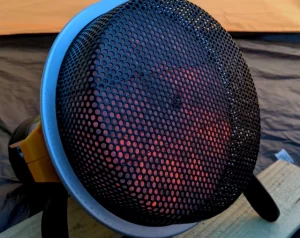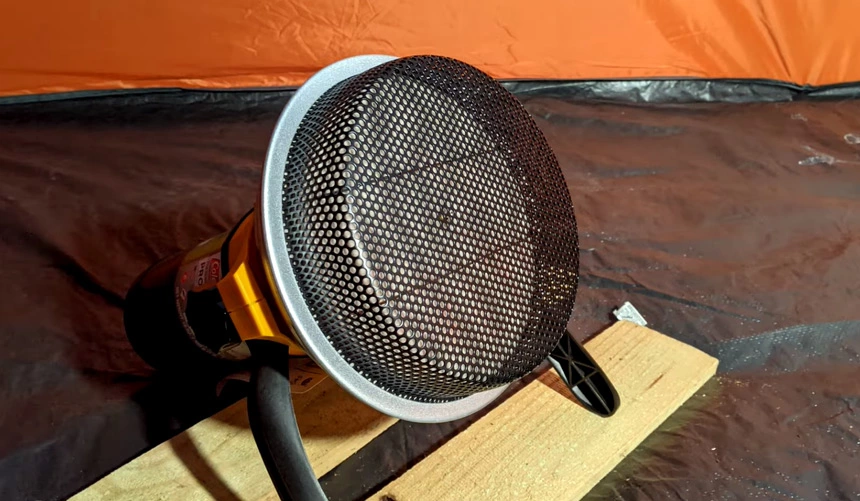Catalytic heaters require no fire to keep you warm on cold-weather camping. But is it safe to use a catalytic heater in a tent?
In general, a catalytic camping heater is safe as long as you maintain safety guidelines. Each heater comes customized with safety measures that are to be maintained by the consumer when operated.
If you end up running a malfunctioned catalytic heater or fail to keep up with the precautions, your tent can get on fire within minutes, or worse, it can affect you with Carbon Monoxide poisoning or other chemical reaction.
Therefore, in this comprehensive guide, we have shared a detailed guideline on catalytic heaters’ pros & cons and how their safety precautions should be maintained. It is better to learn about the secure use of a tent safe heater before getting oneself abducted in the brutality of natural trauma.
Table of Contents
Catalytic Tent Heater: Definition and Usage
As previously mentioned, catalytic heaters require no additional heat source, such as fire to keep your tent warm. Instead, it requires only three things: Oxygen, Catalyst, and Fuel. Fuel as propane or natural gas upholds the heater’s proper execution. And a catalyst is anything that speeds up a chemical reaction for generating heat.
A catalytic heater is a definite solution for campers afraid of using fire. It technically uses a chemical reaction that eventually heats up the temperature of a tent’s enclosed space.
However, even though these heaters require no flame in use, they can inflict dangerous catastrophes if used inadequately. And this is not only applicable for plain heaters; but rather to any other heaters, including a catalytic propane heater or gas heater.
These heaters are designed to operate in a ventilated area. Without proper ventilation, the enclosed space of a tent can get too heated up, and the oxygen levels can get tremendously low. Besides, even though it’s claimed that these heaters are unable to cause carbon monoxide poisoning, at a certain point, they might be able to produce distinctive amounts of carbon monoxide.
Why keep yourself at risk of carbon monoxide on purpose?
While choosing a heater, always check to ensure that it conforms to product safety standards. This means that the heater is safe in its heating process and won’t cause any chemical poisoning. You can also buy a carbon monoxide detector or oxygen depletion sensor for additional alert benchmarks.
I have tried some camping heaters and figured out that no technical machine is supposed to be flawless as its claims. With so many functionalities and features, I have found the Coleman Catalytic Heater the best in this case. However, it still imposes the risk of rapidly lowering the levels of Oxygen in a tent space.
In honesty, this is somewhat common for every other portable heater. The chemical reaction that the catalyst plate uses to forge warmth causes depletion of Oxygen. Especially when you place such heaters in a tiny tent, it gets pretty hot inside. It doesn’t receive proper ventilation to keep the oxygen level at a good tier.
More so, when you have set up your tent, it’s better to have different placement for the heater. Even though the heater will not run on fire consumption, there is a high chance that any flammable objects can ignite flame when in touch with the catalyst plate. Thus, make sure to keep at least a 3″x3″ distance around the area of these heaters while keeping away the ignition stuff.
Storing your catalytic heater too close to your sleeping bag can burn it in ashes. In addition, unattended heaters have a significant possibility of getting knocked over. If you’re inside a closed tent and the weather gets particularly nasty, use the heater outside to warm up rather than risking a fire indoors.
Catalytic Heaters Best Safety Practices
Learning about a catalytic heater’s safety practices works excellent to avoid any implicit dangers. It will not only safeguard the safety of your tent but will also function to provide a heat output that is free of unpleasant threats. Below are the crucial points mentioned regarding the heaters’ safe practices. Forgoing these tips will not be a good idea unless you are ready to bid on an unsafe camping trip.
1. Read The Manufacturer’s Guidelines
I know it’s the most obvious safety tip to suggest, but many campers forget to check on that. Every heater includes a user manual, whether a catalytic or propane tent heater. The manual guide has all the safety features and maintenance crafted by the manufacturer.
You should not avoid this action even if you are already familiar with the usage of catalytic heaters. Remember, each model comes with distinct heat settings. And that’s one of the main reasons every heater model holds an owner manual.
2. Purchase Extra Protective Models
The catalytic heater is a flameless heater that produces no carbon monoxide emissions. However, still be sure to check the product description for any additional safety features like oxygen depletion sensors (ODS), over-heat protection, or spark arrestors.
Some advanced heating machine includes a tip-over protection system. Its job is to shut down the fuel supply immediately once the heater gets tipped over.
On the other hand, the ODS (Oxygen Depletion System) should be in place to keep the occupants safe. The ODS is a high-precision, professional-grade oxygen sensor that reacts to changes in oxygen levels and triggers an alarm when it detects a drop below a safe level.
3. Keep Combustibles Away
It is essential to keep away these fuel-powered heaters from flammable materials. Keep the heater away from your sleeping bag, and anything else at least two feet away from the wall of your tent. To avoid a severe combustion process, it is highly recommended to check all your equipment when running a catalytic heater.
4. Cover The Heater While Not in Use
Protect your heater when you’re not using it. Make sure to place the heater underneath a glass bowl or place a towel over it to prevent dust and other tiny particulates from settling on its catalytic plate. These will increase your heater’s efficiency and reduce the risk of chemical poisoning.
5. Make Room for Adequate Ventilation
Without ventilation, catalytic heaters can decrease the oxygen levels in a room. Low oxygen levels can have serious health effects, like high blood pressure and decreased cognitive function. If you’re using a catalytic heater in a small room, we recommend opening doors and windows and using a low-emission alternative, such as a ceramic heater.
Since many different factors can contribute to low oxygen levels, the following symptoms indicate a potentially dropping O2 level and prompt immediate treatment.
- The 20.9% is the average sea concentration level.
- 12 – 15% can cause slightly increased heart rate and wobbly muscular coordination;
- 10 – 14% causes emotional distortion, breathing difficulty, fatigue on slight movement;
- 6 – 10% is hazardous as it triggers the nervous system for the loss of consciousness, nausea, and dizziness.
- At last, if the oxygen level gets less than 6%, one can face immediate cardiac failure as well as breathing disruption.
Henceforth, make sure you open up the air vents when running your heater. It will let oxygen flow into the tent, replacing the inner hot air from your heater. Keeping this cycle going will keep your tent at a comfortable temperature.
6. Be Wary of Carbon Monoxide Poisoning Symptom
Sometimes you may experience a faint smell of carbon monoxide produced from the heater. It can be due to overuse, overheating, or improper maintenance. Here are the common symptoms of identifying CO poisoning,
- Mild headache
- Nausea and vomiting
- Dizziness
- Muscle pain
- Breathing difficulty
- Fatigue
Having a Portable CO Detector on Tent is Important. It can alert you when your high production levels of Carbon Monoxide are cheap and easy to operate.
Why are catalytic heaters better?

Catalytic portable heaters for camping are a superior choice in several aspects.
Firstly, they have a sleek design and burn cleaner. That means they use less fuel and produce less air pollution. Certified by CSA 4.89, these heaters are safe to use indoors. They work faster and more efficiently, producing more heat than an open-flame heater with less CO emissions.
There’s definitely a tradeoff between safety, performance, and cost. You can enjoy warm and dry conditions while
While non-catalytic and open flame heaters burn propane to produce heat, catalytic heaters cannot operate efficiently with insufficient oxygen. This can result in carbon monoxide poisoning as well as long-term energy loss due to inefficient operation — reducing the overall life expectancy of your propane supply.
Catalytic heaters are more economical and safer than typical open-flame burners. They require around 15% less propane to function and burn for up to 20 hours on one 16.4 oz propane cylinder. Above all, their cost of ownership is lower and lasts much longer because they burn cleaner.
What To Consider While Buying a Catalytic Camping Heater?
Tents require additional safety dealings for the Catalytic heaters, that’s true. But only relying on safety practices can’t help in accident avoidance. If you purchase a faulty machine, you are likely to inflict dangers on yourself and those around you. It can burn the catalyst plate alongside any flammable objects close to it without giving you the time to register the circumstances.
Therefore, you need to purchase the right camping heater that ensures better reliability and security. But what should you consider to finalize a perfect catalytic heater that meets your needs? Nothing much than the functionalities and specifications.
Learning about the different categories of a catalytic heater plays an essential role during its purchase. It allows you to have a thorough understanding of what you need. As every catalytic model doesn’t have every feature in a package, you must figure out a definite specification chart according to your requirements.
Have a clear acknowledgment of which size heater fits your tent. Because once you get the wrong size, it will cover the entire ventilation space, eventually causing severe chemical poisoning inside your tent. So, you must focus on the size during a catalytic heater purchase. It will keep both you and your tent out of danger by providing much space downright.
Another factor to look into when purchasing a catalytic heater is the safety features. Make sure to check whether your desired model has advanced safety features in it. Without ensuring the safety needs, it can be dangerous to purchase a heater. You will not know the heater’s capability to combat Carbon monoxide or other chemical reactive poisonings.
Frequently Asked Questions
Conclusion
The need for catalytic heaters is a must when planning to go on winter camping. These heaters are incredibly tent-friendly and come in several designs perfect for every tent size. However, that doesn’t mean you can use them without taking any safety precautions.
Despite being the safest heating device on the market, it’s essential to sustain safety practices using a tent-safe catalytic heater. It will keep both you and your fellow campers out of potential dangers while allowing you to enjoy a camping trip full of peace.
There should be no worries of fire burn or other chemical hazards in any way. These heaters can keep your cold tent warm and let you enjoy a warmth-filled night in the woods.
But be sure to avoid keeping these heaters turned on during your sleep. No matter how safe a tent heater may be, it’s always risky to keep them ignited in case they get knocked over due to your frequent movement in slumber.
Also, be aware of getting a thorough study on the heater model you want to purchase. When you do that, it will help you know whether the model you selected is compatible with your needs. You will also learn if your tent space will fit a tiny-sized heater or a portable one. Furthermore, it will give you a clear understanding of how the heater operations are customized.



